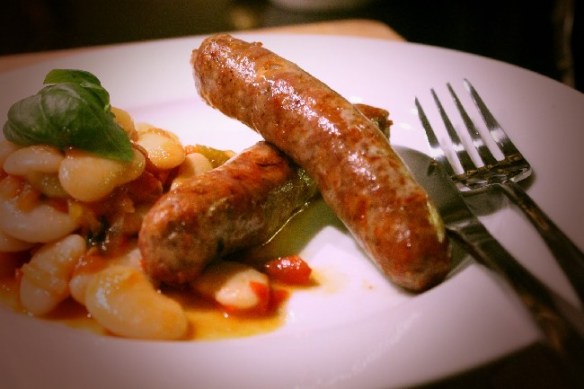It’s Friday evening and that means trying something a little different. Tonight, as we’d not been to the shops for a while, the recipe was inspired somewhat by what I knew we had left in the fridge.
Technically then, not so much inspiration as adaptation, but I unwittingly came up with something we both actually really enjoyed, especially Helen who has spent most of the day ill in bed!
The belly pork needs to be braised for a good while, I did this for 4 hours (using the ‘on-timer’ I have on my oven). I braised it very simply in chicken stock and was virtually falling apart by the time I got back from work. I actually first tried something like this at a local pub who do a version braised in Chinese spices which was also very good, but I wanted something ‘lighter’.
The bean puree was made with butter beans as I had them in the cupboard, but Canellini or Haricot beans would be fine. I had some mixed spinach, watercress and rocket leaves, which I blitzed with it too and added a nice peppery lift. The pickled carrots were based on the pickled mushrooms from the post I made a week ago – it worked well and compliments the richness of the rest of the meal very nicely.
I finished the whole thing off with a reduction made from the pork cooking stock and port.
Serves 2. Takes about 1 hour to make, but needs 4 hours braising time.
Ingredients:
Pork:
- 500g belly pork, not too fatty for this dish.
- 500ml chicken stock
- 3 sage leaves
Butter bean and leaves puree:
- 1 tin butter beans (or 200g dried, soaked and simmered for 40 mins)
- 3 good handfuls of mixed green leaves – I had spinach, rocket and watercress.
- 2 tbsp grated parmesan
- Salt and Pepper
- Tbsp toasted pine nuts
- A little vegetable bouillon stock.
- Small knob of butter
For the carrots:
- 1 large or two small carrots, thinly shaved (use a potato peeler to get the right thickness!)
- 1 tbsp balsamic vinegar
- 1 tbsp white wine vinegar
- 1 tbsp sugar
- 1 tsp salt
- 1 star anise (optional)
For the port reduction:
- About 200ml of the pork cooking stock, fat skimmed from the top
- 2 tbsp port
- Small knob of butter to finish
Method:
Make up some chicken stock if you don’t have any. Arrange the belly pork tightly in a roasting tin (not too big – so it covers the bottom) pour over the stock, sage leaves and salt & pepper. Seal with cooking foil and braise for about 4 hours at 140°C (fan) or Gas 1.
Remove the pork and set aside. Pour the fat from the top of the cooking liquor and strain it through a sieve (or muslin cloth) into a bowl for later.
Drain the beans, if using tinned, and place in a pan, cover with stock and simmer until heated through. Place the mixed leaves on top and allow to wilt down in the heat. Pour out the stock (and reserve in case you need it) and put the contents in a food processor or, if you’re feeling old-school, a pestle and mortar in batches. Blitz or pound until you get a puree. I left a few lumps in as I prefer it that way. You may need to add some of the reserved stock if it’s too dry.
Put it back in the pan and stir in the Parmesan, pine nuts and the butter and warm gently, reducing slightly if it’s too ‘wet’. Turn the heat off and cover until needed.
To make the pickled carrots, simply peel then shave them using a potato peeler, or use a very sharp knife to get thin strips. Put in a small pan with all the other ingredients and bring to a gentle simmer for a few minutes. Taste the liquor and adjust it as you see fit, but this worked for me.
Get a heavy frying pan and add a little oil. Get it hot and colour the braised belly pork on each side, it smells amazing. Remove and wrap in foil to rest/keep warm. Add about 200ml of the reserved pork cooking stock and the port to the pan and reduce on a medium heat for a while. When thickened, take it off the heat and whisk in a knob of butter.
Plate it all up and enjoy. Another long one, but well worth it!


















